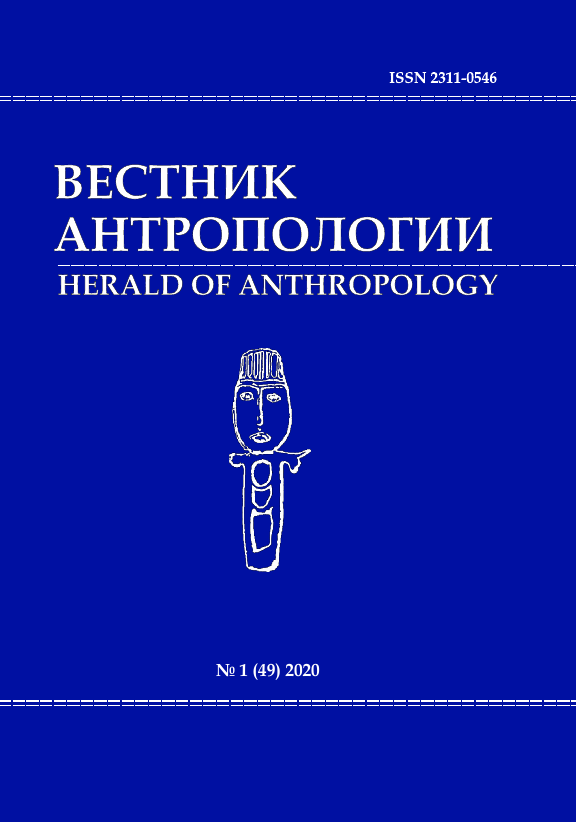Traditional Wedding Rites of the Dungan in Kazakhstan: a comparative historical analysis
DOI: 10.33876/2311-0546/2020-49-1/147-162
Keywords:
Dungan diaspora, traditional wedding rituals, intercultural interactions, comparative-historical analyses, process-tracing analysesAbstract
The article is dedicated to the traditional wedding rites of the Dungan diaspora in Kazakhstan. The Dungan are descendants of the Huízú, who arrived in Kazakhstan, Kyrgyzstan and Uzbekistan voluntarily after a failed uprising against the Qing Dynasty in 1877–1888.
Based on a comparative historical analysis, the article discusses the differences in the wedding ceremonies of the Dungans, who live compactly in three areas – the Zhambyl region of Kazakhstan (the villages of Zhalpak-Tobe, Sortobe) and Almaty (the village of Zarya Vostoka). The traditional wedding ceremonies vary greatly due to close cultural and social contacts of the Dungan with Kazakhs, Uzbeks, Uighurs and Russians. The case of wedding rites demostrate that the fact that the Dungan are surrounded by a different cultural environment, on the one hand, stimulates the consolidation of an ethnic group and preservation of many traditional archaic cultural traits, and, on the other hand, leads to the transformation of marriage ceremonies. This is illustrated by the changes in the bride’s traditional clothes, hats, music, dances, as well as the replacement and simplification of the wedding rituals such as receiving guests and others.
References
- Allès, E. 2000. The Dungans and the Marriage Ceremony: A Case of Multiple Identities. China Perspectives 27: 62–69.
- Bakirov, R.B. 04.07.2014. Pod odnim shanyrakom: dunganskaia svad’ba – drevnie traditsii v sovremennom voploshchenii [Under One Shanyrak: Dungan Wedding – Ancient Traditions in Modern Imbodiment]. Taraz Kazinfom. 04.07.2014. https://www.inform.kz/ru/pod-odnim-shanyrakom-dunganskaya-svad-ba-drevnie-tradicii-v-sovremennom-voploschenii_a2674679
- Davenel, Y.-M. 2012. Cultural Mobilization in Post-Soviet Kazakhstan: Views from the State and from Non-Titular Nationalities Compared. Central Asian Survey 31 (1): 17–21.
- Demko, G. 1969. The Russian Colonization of Kazakhstan, 1896–1916. Bloomington: Indiana University Publications.
- Dilmanov, S. 2006. Ispravitel’nye trudovye lageria na territorii Kazakhstana (1930–1956) [Correctional Labor Camps on the Territory of Kazakhstan (1930–1956)]. Almaty.
- Ding, Hong. 2005. A Comparative Study on the Cultures of the Dungan and the Hui Peoples. Asian Ethnicity 6 (2): 135–140.
- Dzhon, A.A. 2007. Obychai, obriady, pover’ia Dungan [Dungan Customs, Rituals and Beliefs]. Bishkek: Ilim.
- Dzhon, A.A. 2016. Obychai, obriady i pover’ia Dungan Tsentral’noi Azii [Dungan Customs, Rituals and Beliefs in Central Asia]. Bishkek: Ilim.
- Dzhon, A.A., and F.N. Khavaza. 2016. Izmeneniia v antroponimii dungan (khueitszu) kak marker identichnosti [Change in Dungan (Huizu) Anthroponymy as a Marker of Identity]. In Kitai: istoriia i sovremennost’. Materialy IX Mezhdunarodnoi nauchno-prakticheskoi konferentsii “Kitai: istoriia i sovremennost” [China: History and Present], edited by S.V. Smirnov, 63–70. Ekaterinburg: Izdatel’stvo Ural’skogo federal’nogo universiteta.
- Garin, S. 1952. Milianfan: dolina risa. Ocherk [Milianfan: Valley of Rice]. Moscow: Pravda.
- Ercilasun, K. 2017. Kazakhstan, Kyrgyzstan, and Uzbekistan. Life and Politics during the Soviet Era. In Soviet Agricultural Policy and Cultivating “Virgin Lands” in Kazakhstan, edited by T. Dadabayev and H. Komatsu, 53–65. New York: Palgrave Macmillan.
- Fedorov, D. 1903. Opyt voenno-statisticheskogo opisaniia Iliiskogo kraia [The Experience of the Military Statistical Description of the Ili Region]. Vol. I–II. Tashkent: Izdanie Shtaba Turkestanskogo voennogo okruga.
- Hu, Zhenhua. 2014. Small Nation for Big Work. Journal Kitai 10: 58–59.
- Imazov, M. 2009. Dunganskaia entsiklopediia [Dungan Encyclopedia]. Bishkek: Ilim.
- Jimenez, S. 2014. A Centripetal Mirrors: Cultural Conservation among Shaanxi Dungans in Kazakhstan. PhD diss., Max-Planck Institut für ethnologische Forschung, Abteilung Integration und Konflikt.
- Lawrence, K. 1966. Peoples of Central Asia. Bloomington: Indiana University Publications.
- Lillis, J. 2010. Astana Follows Thorny Path toward National Unity. EurasiaNet. 29 April. http://www.eurasianet.org/node/60952
- Nekrich, A.M. 1978. The Punished Peoples: The Deportation and Fate of Soviet Minorities at the End of the Second World War. New York: Norton.
- Poiarkov, F. 1901. Poslednii epizod dunganskogo vosstaniia (Malen’kaia stranichka iz proshloi zhizni Semirech’ia) [The Last Episode of the Dungan Revolt (A Small Page from Past Life of Semirechie)]. Vernyi.
- Poiarkov, F.V. 1903. Svatovstvo (She-mii) u dungan [Matchmaking from the Dungan (Shemi)]. Etnograficheskoe obozrenie 2: 38–75.
- Poiarkov, F. 1907. Dungane (Svad’ba-sifur) [Dungan (Weddings)]. Vernyi.
- Reshetov, A. 1972. Ob etnicheskom svoeobrazii khuei i urovne ikh etnicheskoi solidarnosti [About Ethnic Identity of Hui People and Level of Their Solidarity]. Etnicheskaia istoriia narodov Azii [Ethnic History of People of Asia], edited by. S.M. Abramzon and R.F. Its, 137–149. Moscow: Nauka.
- Rimsky-Korsakoff Dyer, S. 1978. Soviet Dungan Weddings: Symbolism and Traditions. Monumenta Serica 33: 363–378.
- Rosaldo, R. 1994. Cultural Citizenship in San Jose, California. PoLAR 17 (2): 57–64.
- Savurov, M. 2007. Dunganskaia sem’ia: proshloe i nastoiashchee [Dungan Family: Past and Present]. Tashkent.
- Selitskii, I. 2017. Kul’dzhinskie pereselentsy pogranichnoi s Kitaem polosy (Ekonomichesko-etnograficheskie ocherki i bytovaia zhizn’ Zharkentskikh taranchei i dungan) [Kulja Migrants: Economic-Ethnographic Notes about the Life of the Taranchin and Dungan]. In Dungane. Istoriia i kul’tura. Rossiiskie dorevoliutsionnye raboty o dunganakh [Dungan History and Culture: Russian Pre-Revolutionalry Works about Dungans], edited by M.R. Madivan and O.I. Zavialova, 184–192. Moscow: Vostochnaia literatura.
- Schatz, E. 2000. Framing Strategies and Non-Conflict in Multi-Ethnic Kazakhstan. Nationalism and Ethnic Politics 6 (2): 71–94.
- Stratanovich, G. 1950. Dunganskii narod Kirgizskoi SSR [Dungan People of Kirghiz SSR]. In Rukopisnyi fond otdela sotsial’nykh nauk Natsional’noi akademii nauk Kazakhstana. Rukopis’ [Fund of the Department of Social Sciences of National Academy of Sciences of Kazakhstan. Manusrcipts]. Inv. № 152. Alma-Ata.
- Sushanlo, M. 1979. Sem’ia i semeinyi byt Dungan [The Dungan Family and Their Way of Life]. Frunze: Ilim.
- Tolstov, S., ed. 1963. Narody Srednei Azii i Kazakhstana [Peoples of Central Asia and Kazakhstan]. Vol. 2. Moscow: Akademiia nauk.
- Tsibuzgin, V., and A. Shmakov. 1909. Zametka o zhizni dungan seleniia Karakunuz Pishpekskogo uezda Semirechenskoi oblasti [Note about the Life of the Dungan Settlement of the Karakunuz Pishpeksky District of the Semirechye Region]. In Zapiski Semipalatinskogo podotdela Zapadno-Sibirskogo otdela Imperatorskogo Russkogo geograficheskogo obshchestva 4.
- Wing-tsit, Chang. 1953. Religious Trend in Modern China. New York: Columbia University Press.





















